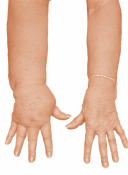Understanding Lymphedema
- "Understanding Lymphedema" is also available in Portable Document Format (PDF, 463KB, 2pg.)
If you have ever had radiation, surgery for cancer, trauma, burns, infections, or other surgical procedures particularly involving the arms and legs or lymph nodes, lymphedema is something that you need to know about.
What is lymphedema?
Lymphedema (LIMF-eh-DEE-ma) is the buildup of lymph fluid in your body's tissues that can happen when lymph nodes are removed or damaged. Lymphedema can cause swelling anywhere in the body, but most often happens in the arms and/or legs. Lymphedema results from common cancer treatments such as surgery and radiation but can occur as a result of trauma, burns, infections or other surgical procedures. It can develop soon after treatment, or may show up many months, years, or even decades later.


Photos courtesy of Lymphedema Therapy, Woodbury, NY
Lymphedema can:
- lead to infections
- cause pain and discomfort
- be a long-term condition
- be controlled through awareness and treatment
Once you develop lymphedema, it can be managed, but it cannot be cured. It is important that you do everything you can to help prevent it from developing.
What are the Symptoms of Lymphedema?
The symptoms of lymphedema often appear slowly over a period of years. Even if you don't develop symptoms right away, you may still be at risk. If you have had surgery or radiation treatment for cancer, or have had trauma, burns, infection or other surgical procedures and begin to notice any of the following symptoms, you may have lymphedema, and should call a doctor:
- pain, aching, or redness in an arm or leg, including fingers or toes
- swelling (with or without pain) anywhere in your body that lasts for 1 to 2 weeks
- jewelry or clothing feels tight but there is no weight gain
- a feeling of weakness, heaviness, or tightness in the arm or leg
- repeated infections in the arm or leg
- hardening and thickening of the skin on the arm or leg
- a temperature of 100.5 degrees Fahrenheit or higher that isn't related to a cold or flu
What is the treatment for lymphedema?
If you have lymphedema, there is effective treatment to reduce the swelling, prevent the condition from getting worse, and limit the risk of infection. Experts generally recommend Complete Decongestive Therapy (CDT) for people with lymphedema. CDT is a combination of treatments that include special massage for lymph drainage, exercises, compression, and skin care. These treatments should be given by a certified lymphedema therapist or someone who has received special lymphedema therapy training. Early treatment focuses on reducing the swelling and controlling the pain, and can shorten the time that treatment is needed.
It is important that you be involved in your lymphedema treatment:
- So that you can better understand the signs and symptoms of lymphedema, contact any of the organizations listed on the back of this brochure.
- Get professionally fitted for a compression garment. To find a certified lymphedema therapist, see the National Lymphedema Network or the Lymphology Association of North America contact information listed on the back of this brochure.
Infection is a common problem with lymphedema. To protect against infection:
- use antibacterial creams for all cuts, scrapes, insect bites, etc. on the affected arm or leg
- use the unaffected arm for blood tests, IVs, injections, and blood pressure readings
- wear protective gloves when doing chores such as washing dishes or gardening
- frequently apply fragrance-free, hypoallergenic lotion to avoid dry, chapped skin
If any part of your affected arm or leg feels hot, looks red, or swells suddenly, you should call your doctor as these symptoms could be a sign of an infection and you may need antibiotics.
Where can I get support for lymphedema?
Attend lymphedema support group meetings in your community. These meetings are a good way to connect with people who understand what you're going through. The National Lymphedema Network website or hotline can provide a list of support groups around the country.
Participate in online message boards and chat rooms. Make sure that the site you go to is recommended by a reputable source, such as The National Lymphedema Network. If you don't have internet access, call any of the hotline numbers listed at the end of this pamphlet.
Can lymphedema be prevented?
While there is currently no cure for lymphedema, there are things you can do to reduce your risk of developing lymphedema. The risk of lymphedema is life-long. Following these preventative steps will greatly reduce the possibility that you will develop lymphedema:
DO
- rest your arm or leg while recovering
- exercise and stretch, but avoid strenuous activities, such as those that make you sweat, until after you've completely recovered from surgery or radiation
- talk to your health care provider about whether you should wear a professionally fitted compression garment, which is a long sleeve or stocking made to compress the arm or leg to encourage the flow of lymph fluid out of the affected arm or leg

- protect your arms and legs from sunburns or other burns
DON'T
- don't wear clothing or jewelry that feels tight or uncomfortable
- don't carry heavy items or do repetitive activities until you are fully healed. First check with your health care provider
- don't apply heat, such as with a heating pad, to your affected limb
- don't use hot tubs or saunas
For further information on lymphedema
- Lymphatic Education and Research Network
516-625-9675 - American Cancer Society
1-800-ACS-2345 - National Cancer Institute
1-800-4-CANCER - Susan G. Komen Breast Cancer Foundation
1-877 GO KOMEN (1-877-465-6636)
To find a certified lymphedema therapist
- Lymphology Association of North America (LANA)
1-773-756-8971 - National Lymphedema Network
1-800-541-3259